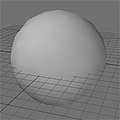Shading
Shading or Shading is a term used in 3D computer graphics , which is the simulation of the surface properties of objects in the broad sense. In particular, shading refers to the use of an interpolation method with which the normal vector is calculated on any point of a polygon network . Interpolative shading techniques can be used to make surfaces look "smoother".
Interpolative shading techniques
- Flat shading (also constant shading, faceted shading or constant shading ) does not perform any interpolation, but rather uses the color of a vertex of the polygon to be drawn. This color is used for all points on the polygon.
- With Gouraud shading (also intensity interpolation shading or color interpolation shading ) the lighting is applied to the vertices of the polygon, but the color values of the individual pixels are interpolated from the color values of the vertices.
- Phong Shading (also normal-vector interpolation shading ) interpolates an interpolated normal of the pixel from the normals of the vertices for each pixel and applies the lighting model for each pixel with a new normal.
Sphere with Lambertian lighting model and flat shading
Shading in general
For shading in a broad sense, see Material (3D computer graphics) .
literature
- Tomas Akenine-Möller: Real-Time Rendering, pp. 70 ff. AK Peters, Wellesley (MA) 2002, ISBN 1-56881-182-9
- Hans-Joachim Bungartz et al.: Introduction to Computer Graphics, pp. 154–158. Vieweg, Braunschweig 2002, ISBN 3-528-16769-6
- Prof. Dieter Orlamünder, Wilfried Mascolus: Computer graphics and OpenGL: A systematic introduction , p. 252ff. Carl Hanser, 2004, ISBN 3-44640-072-9
- Alan Watt: 3D Computer Graphics, pp. 179-183. Pearson, Harlow 2000, ISBN 0-201-39855-9
Individual evidence
- ↑ Bungartz, p. 154
- ↑ See for example Watt, Chapter 6.2 "Shading pixels"
- ↑ James D. Foley et al: Computer Graphics: Principles and Practice, p. 734. Addison-Wesley, Reading (MA) 1997, ISBN 0-201-84840-6

